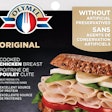The White House posted the text of the Trans-Pacific Partnership (TPP) trade agreement on Nov. 5, prompting the start of a public review process of the deal between Australia, Brunei, Chile, Canada, Japan, Malaysia, Mexico, New Zealand, Peru, Singapore, the United States and Vietnam. U.S. poultry producers have long been advocates of free and fair trade, currently exporting almost 20 percent of production, and expressed strong support upon the release of the text.
"The National Chicken Council (NCC) applauds U.S. Trade Representative Michael Froman and his team of negotiators for their years of work on the TPP, and urge expeditious congressional approval," said NCC President Mike Brown. "The TPP represents a commercially meaningful and high standard agreement that will open markets and increase U.S. chicken exports and bring increased economic benefits to chicken farmers and companies across the country. Without it, U.S. chicken exports to the TPP region will face a significant competitive disadvantage."
USA Poultry & Egg Export Council President Jim Sumner added, "With Canada, Vietnam and Japan already some of our most important markets, this should provide a great opportunity to expand U.S. poultry exports. Our industry is most appreciative of the emphasis given to all of our products during the lengthy negotiation process by the USTR team."
The following provisions of the agreement are of special importance to U.S. broiler producers:
Japan
The United States exported $128 million of poultry and poultry products to Japan in 2014. Japan's tariffs are currently as high as 21.3 percent, or 48 yen per kilogram, whichever is greater (approximately 24.1 percent ad valorem equivalent). Under the TPP agreement, tariffs on all poultry, eggs, and egg products will be eliminated in 6-13 years.
The United States is the dominant supplier of frozen poultry leg exports to Japan. The United States holds a 95-percent market share, valued at $41 million in 2014. Japan's current 8.5-percent tariff on frozen poultry legs will be eliminated within 11 years. Tariffs on fresh and frozen cuts, currently as high as 11.9 percent, will be eliminated in 6-11 years.
Vietnam
The United States exported $92.7 million of poultry and poultry products to Vietnam in 2014. Vietnam's tariffs on poultry and poultry meat, currently as high as 40 percent, will be eliminated within 13 years. This includes tariffs on frozen chicken cuts and offal, which will be eliminated in 11 years.
Canada
Canada will establish new TPP-wide, duty-free TRQs for chicken, turkey, eggs, egg products, and hatching eggs and chicks. Over six years, the TRQs will grow by 23,500 metric tons (MT) for chicken and 1 million dozen for hatching eggs and chicks. After that, the TRQs will grow by one percent annually for 13 more years. (The access level for chicken and chicken products TRQ negotiated under NAFTA is 7.5 percent of Canada's previous year's domestic chicken production as reported by Statistics Canada: 77,025 MT in 2012 and over 80,000 MT in 2014.)
Finally, the agreement includes a sanitary and phytosanitary measures section meant to prevent countries from using standards for food safety and animal and plant health as trade barriers. NCC and USAPEEC have long been advocates of achieving a strong commitment on enforcement, in particular in the area of sanitary and phytosanitary measures.














